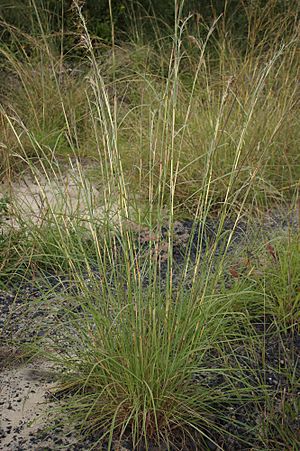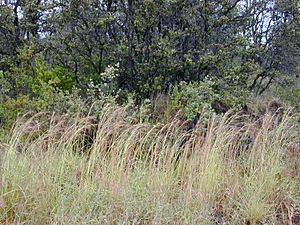Jaraguá facts for kids
Quick facts for kids Jaraguá |
|
|---|---|
 |
|
| Scientific classification | |
| Genus: |
Hyparrhenia
|
| Species: |
rufa
|
| Synonyms | |
|
Synonyms
Andropogon altissimus
Andropogon bonangensis Andropogon bouangensis Andropogon fulvicomus Andropogon hirtus Andropogon rufus Andropogon xanthoblepharis Andropogon yinduensis Cymbopogon rufus Hyparrhenia altissima Hyparrhenia fulvicoma Hyparrhenia parvispiculata Hyparrhenia yunnanensis Sorghum rufum Sorghum xanthoblepharis Trachypogon rufus |
|
Hyparrhenia rufa, also known as jaraguá grass or giant thatching grass, is a type of grass. It originally comes from Africa. Today, you can find it all over the world. People often grow it to feed farm animals. Sometimes, it grows wild in new places and can even become an invasive plant.
Contents
What Does Jaraguá Grass Look Like?
This grass usually lives for many years (it's a perennial), but sometimes it grows for only one year (it's an annual). It can look different depending on where it grows.
It often forms thick clumps of stems that grow from a short underground stem called a rhizome. The stems can be anywhere from 30 centimeters (about a foot) to 3.5 meters (about 11 feet) tall! The leaves wrap around the stem, making it look like it has bands. Stems that are flowering have fewer leaves. However, if animals eat the grass, it grows more leaves. The leaf blades themselves can be 30 to 60 centimeters (about 1 to 2 feet) long.
The grass produces a large flower cluster called a panicle, which can be up to 80 centimeters (about 2.5 feet) long. This panicle is made of many smaller, short flower branches called racemes. These racemes are yellowish or have a red tint. Each raceme has pairs of tiny flowers called spikelets. Some spikelets are fertile and have red hairs, while others are smaller and don't have stalks.
The seeds of jaraguá grass have rough hairs. They can spread in many ways:
- Sticking to animal fur.
- Carried by the wind.
- Moved by vehicles and farm machines.
Where Does Jaraguá Grass Grow?
In its home areas, jaraguá grass grows in woodlands and grasslands that get flooded during certain times of the year. It can also handle drought (very dry weather). It easily starts growing in places where the land has been disturbed, like construction sites or fields.
Jaraguá Grass and Ants
Some types of leafcutter ants, like Atta capiguara, like to collect jaraguá grass. They use it to grow their fungus gardens inside their nests.
Plant Problems for Jaraguá Grass
This grass can be affected by tiny worms called nematodes, which can cause plant diseases. Some of these nematodes are Helicotylenchus pseudopaxilli, Pratylenchus brachyurus, and Longidorus laevicapitatus.
It can also get a disease caused by a type of bacteria called phytoplasma. This disease makes other grasses, like Napier grass, stop growing properly. When jaraguá grass gets this infection, it's called Hyparrhenia grass white leaf disease.
Jaraguá Grass as Animal Food
Farmers often grow jaraguá grass in pastures for animals to graze on. They also cut it to make fodder, which includes hay (dried grass) and silage (fermented grass). It's commonly used to feed beef cattle. It's also given to dairy cattle, sheep, and goats.
Jaraguá grass is not super nutritious on its own. So, farmers usually add other things to the animals' diet. They might add legumes (like beans or peas) for nitrogen (a nutrient) or things like molasses, citrus pulp, or bran for energy. For goats, a mix of groundnut cake and wheat bran has been tried as a supplement. Some legumes added to the diet include Cratylia argentea, Erythrina poeppigiana, Gliricidia sepium, and Leucaena leucocephala. The grass has less protein and is harder to digest during the dry season.
When Jaraguá Grass Becomes a Weed

When jaraguá grass is brought to new places for farming, it often starts growing wild. Sometimes, it becomes an invasive species and takes over the local plants. For example, in the Llanos region of South America, it grew easily in the moist grasslands, which were similar to its original home. It was brought there to feed animals because the native grasses were not as nutritious.
Scientists think jaraguá grass outcompetes native grasses, like Trachypogon plumosus, for several reasons:
- It grows faster.
- It's better at photosynthesis (making food from sunlight).
- Its seeds sprout more easily.
- It uses water more efficiently.
- It puts more energy into growing leaves.
- It handles being eaten by plant-eating animals better.
This grass often spreads by growing new shoots from its roots (this is called vegetative reproduction). But it also makes many seeds that can easily grow into new plants.
Jaraguá Grass and Wildfires
Jaraguá grass is a pyrophyte. This means it is very well-suited to places that have wildfires every year. During the dry season, it becomes very easy to burn. Wildfires in areas with native grasses are usually small and don't spread much. However, H. rufa can form thick, tall patches of only its own kind of grass. These patches catch fire easily, burn very hot, and can spread fire into nearby forests.
Not only does the grass make wildfires worse, but it actually grows better after a fire! The dry parts might burn away, but the living parts near the ground are not harmed. They quickly grow back. Fire damage to a patch of jaraguá grass is usually "negligible," meaning it's almost nothing.
Today, this grass is considered a weed in most tropical parts of the world. You can find it in North, Central, and South America, many Pacific Islands, parts of Africa outside its native range, and Australia.
Other Uses for Jaraguá Grass
This tall grass has other uses too:
- It can be used for thatching roofs.
- It can be used as straw.
- It can be made into pulp for making paper.
- In East Africa, people plant it along borders to stop soil from washing away (this is called preventing erosion).
See also
 In Spanish: Jaraguá para niños
In Spanish: Jaraguá para niños

